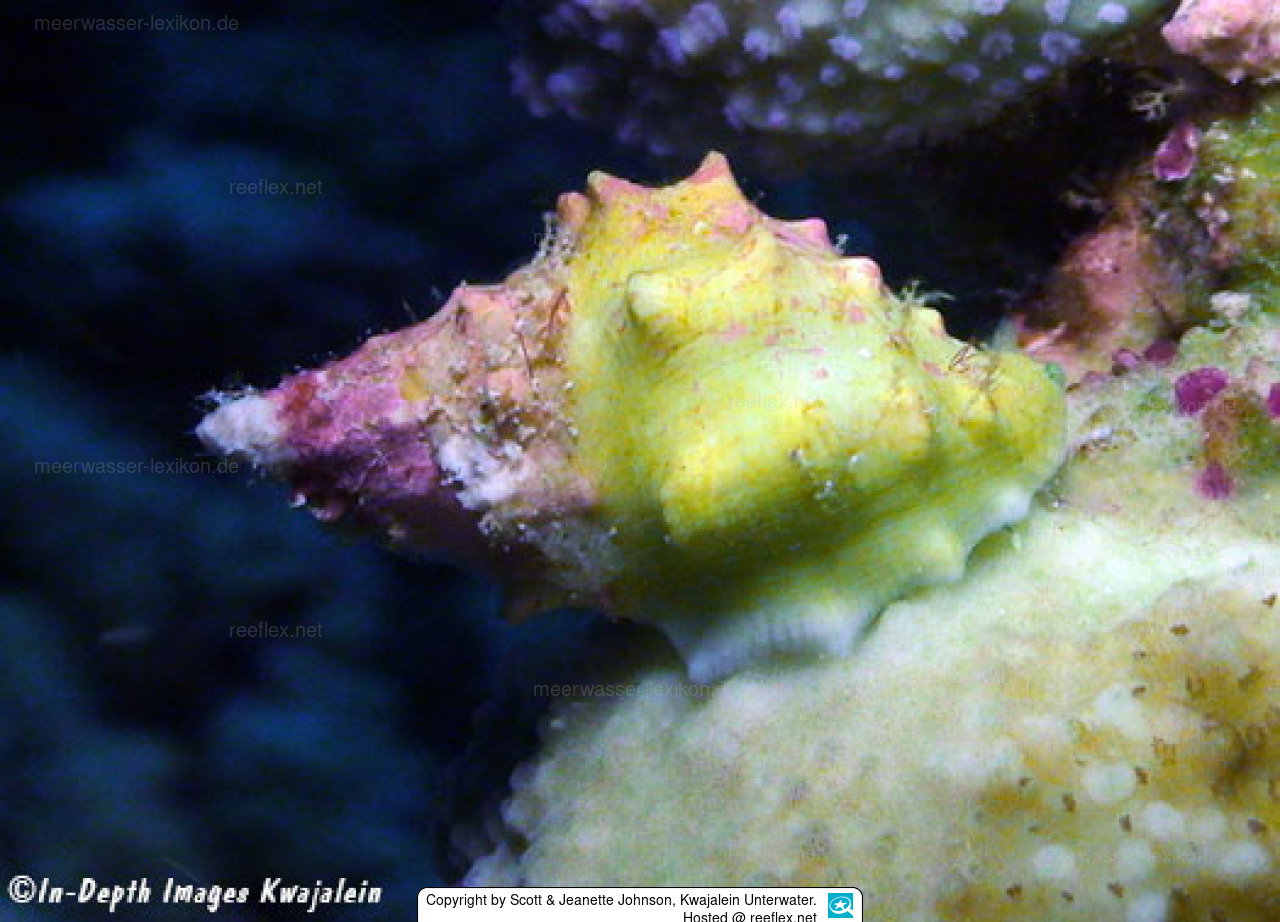Info
Drupella cornus (Born, 1778)
Drupella cornus is a widespread shell snail, which is parasitic, and that also gladly in large troops, on stony corals, especially gladly on Arcopora.
The snail is corallivorous, i.e. it feeds on coral tissue and coral polyps, it is capable of destroying entire canes by its continuous feeding activity, what remains is a dead calcareous skeleton.
Scott Johnson's photos show the quantities of snails that besiege and feed on the corals.These coral parasites do not stop at other coral genera, they also attack Porites in Kenya, and Pocillopora and Porites in Hawaiii, and Montipoa in Indonesia, however the snails seem to prefer Acropora.
Healthy coral reefs can withstand some feeding pressure from predators, but when the populations of parasites literally explode, see also the crown-of-thorns starfish (Acanthaster planci), even vital reefs suddenly have a very big problem, as the reefs in this critical condition are additionally weakened by El Niño phenomena and human interference (pollution, introduction of fertilizers, poisons, etc.).
When buying new corals, please scan the sticks carefully and remove snails with the help of tweezers to avoid possible encroachment on existing corals.
Synonymised names
Drupa concatenata (Lamarck, 1822) · unaccepted > junior subjective synonym
Drupella concatenata (Lamarck, 1822) · unaccepted > junior subjective synonym
Morula concatenata (Lamarck, 1822) · unaccepted > junior subjective synonym
Murex concatenatus Lamarck, 1822 · unaccepted > junior subjective synonym
Murex rugosa Born, 1778 · unaccepted
Purpura alveolata Reeve, 1846 · unaccepted (invalid: junior homonym of...)
Purpura subturrita Blainville, 1832 · unaccepted (synonym)
Ricinula concatenata (Lamarck, 1822) · unaccepted > junior subjective synonym
Thais alveolata (Reeve, 1846) · unaccepted
Thais rugosa (Born, 1778) · unaccepted
Drupella cornus is a widespread shell snail, which is parasitic, and that also gladly in large troops, on stony corals, especially gladly on Arcopora.
The snail is corallivorous, i.e. it feeds on coral tissue and coral polyps, it is capable of destroying entire canes by its continuous feeding activity, what remains is a dead calcareous skeleton.
Scott Johnson's photos show the quantities of snails that besiege and feed on the corals.These coral parasites do not stop at other coral genera, they also attack Porites in Kenya, and Pocillopora and Porites in Hawaiii, and Montipoa in Indonesia, however the snails seem to prefer Acropora.
Healthy coral reefs can withstand some feeding pressure from predators, but when the populations of parasites literally explode, see also the crown-of-thorns starfish (Acanthaster planci), even vital reefs suddenly have a very big problem, as the reefs in this critical condition are additionally weakened by El Niño phenomena and human interference (pollution, introduction of fertilizers, poisons, etc.).
When buying new corals, please scan the sticks carefully and remove snails with the help of tweezers to avoid possible encroachment on existing corals.
Synonymised names
Drupa concatenata (Lamarck, 1822) · unaccepted > junior subjective synonym
Drupella concatenata (Lamarck, 1822) · unaccepted > junior subjective synonym
Morula concatenata (Lamarck, 1822) · unaccepted > junior subjective synonym
Murex concatenatus Lamarck, 1822 · unaccepted > junior subjective synonym
Murex rugosa Born, 1778 · unaccepted
Purpura alveolata Reeve, 1846 · unaccepted (invalid: junior homonym of...)
Purpura subturrita Blainville, 1832 · unaccepted (synonym)
Ricinula concatenata (Lamarck, 1822) · unaccepted > junior subjective synonym
Thais alveolata (Reeve, 1846) · unaccepted
Thais rugosa (Born, 1778) · unaccepted







 Scott & Jeanette Johnson, Kwajalein Unterwater
Scott & Jeanette Johnson, Kwajalein Unterwater










